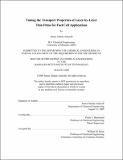Tuning the transport properties of layer-by-layer thin films for fuel cell applications
Author(s)
Ashcraft, James Nathan
DownloadFull printable version (24.00Mb)
Other Contributors
Massachusetts Institute of Technology. Dept. of Chemical Engineering.
Advisor
Paula T. Hammond.
Terms of use
Metadata
Show full item recordAbstract
The increasing global focus on alternative energy sources has led to a renewed interest in fuel cells. For low power, portable applications, direct methanol fuel cells (DMFCs) are the most promising type of fuel cell. DMFCs can operate at ambient conditions and only require dilute methanol solutions and air to be input to the devices. At the core of these devices is a proton exchange membrane (PEM) that allows rapid proton transport through the polymer matrix while preventing fuel from permeating across. Additionally, PEMs must have long-term stability in the fuel cell environment, the ability to operate over a wide range of conditions (temperature and humidity), and be cost effective. A promising, robust method for fabricating polymer films with tunable properties is layer-by-layer (LbL) assembly. This technique consists of building a polymer film by sequential dipping into polymer solutions with complementary interactions, such as opposite electrostatic charges. The LbL method allows the formation of thin films that have perm-selective properties and high ionic conductivity values. This work describes the optimization of multilayer systems for use as the PEM in DMFCs. First, LbL assembled films of poly[bis(methoxyethoxyethoxy)-phosphazene] (MEEP) and poly (acrylic acid) (PAA) are demonstrated by utilizing the hydrogen bonding between these two polymers. These films show controlled thickness growth, high ionic conductivity, and excellent hydrolytic stability. The ionic conductivity of these films is optimized by tuning the assembly pH of initial polymer solutions and thereby controlling the hydrogen bonding characteristics. (cont.) Despite similar film composition, MEEP/PAA LbL films assembled at higher pH values have enhanced water uptake and transport properties, which play a key role in increasing ion transport within the films. At fully humidified conditions, the ionic conductivity of MEEP/PAA is over one order of magnitude higher than previously studied hydrogen bonded LbL systems. The next LbL systems studied consist of a highly sulfonated aromatic polyether (sPPO) paired with amine containing polycations. The best performing sPPO system has ionic conductivity values which are the same order of magnitude as commercially relevant PEMs and has the highest ionic conductivity ever obtained from a LbL assembled film. Additionally, these LbL systems have methanol permeability values over two orders of magnitude lower than traditional PEMs. Incorporating the sPPO systems into DMFCs results in a 53% improvement in power output as compared with DMFCs using traditional PEMs. In-depth structure property studies are performed to understand the nature of the high ionic conductivity of the sPPO LbL systems with respect to film growth, composition, water uptake, and ionic crosslink density. Lastly, the mechanical properties of highly conducting LbL films are improved by forming the LbL matrix on highly tunable electrospun fiber mat (EFM) supports. Free-standing LbL films have moderate mechanical properties when dry, but are mechanically deficient when hydrated. Coating an EFM with the LbL dipping process produces composite membranes with interesting "bridged" morphologies, while still maintaining high ionic conductivity values. (cont.) The spray LbL assembly is studied as a means for the rapid formation of LbL films on EFMs. At optimized conditions, the LbL materials conformally coat the individual fibers throughout the bulk of the EFM and have uniform surface coatings. The mechanical properties of the spray coated EMFs are shown to be superior to the pristine LbL systems.
Description
Thesis (Ph. D.)--Massachusetts Institute of Technology, Dept. of Chemical Engineering, 2009. This electronic version was submitted by the student author. The certified thesis is available in the Institute Archives and Special Collections. Cataloged from student submitted PDF version of thesis. Includes bibliographical references (p. 138-148).
Date issued
2009Department
Massachusetts Institute of Technology. Department of Chemical EngineeringPublisher
Massachusetts Institute of Technology
Keywords
Chemical Engineering.